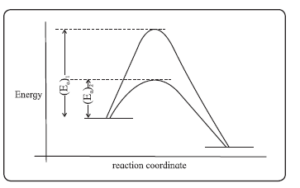chapter 6. CHEMICAL KINETICS class 12 chemistry textbook solution
3. Answer the following in brief.
viii. How catalyst increases the rate of reaction? Explain with the help of potential energy diagram for catalyzed and uncatalyzed reactions.
Answer:-

i. A catalyst provides an alternative pathway associated with lower activation energy.
Potential energy barriers for catalyzed and uncatalyzed reactions
ii. The potential energy diagram compares the potential energy barriers for the catalyzed and uncatalyzed reactions. The barrier for the uncatalyzed reaction (Ea) is larger than that for the same reaction in the presence of a catalyst, Ea.
iii. Consider the decomposition of H2O2 in aqueous solution catalyzed by I- ions:
2H2O2(aq) → [I-]2H2O(l) + O2(g)At room temperature, the rate of reaction is slower in the absence of a catalyst with its activation energy being 76 kJ mol-1. In the presence of a catalyst, iodide ion (I-), the reaction is faster since the activation energy decreases to 57 kJ mol-1.
